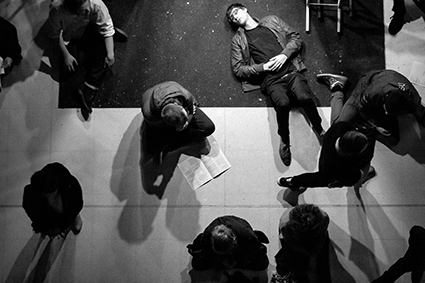 |
Akousmatikoi (The Listeners) photo Holly Jade |
All of the evening’s composers produced site-specific works that played on the strengths of the speaker-setup, which includes a series of powerful subwoofers situated on a gangway high above the audience. Kynan Tan’s piece, multitemporal, uses sets of big data, including DNA sequences, to control the production and diffusion of sound in the space. Bassy hums and zinging atoms zipped around the room, becoming more drawn-out and granulated as the work progressed before coalescing into insect-like clicks. These were particularly clear when projected from the small tweeters hanging along the gangway above the audience.
Chris Cobilis took a different approach from Tan, using immediately recognisable samples of human voices and instruments in his Preludes Nonplussed. Exploring similarities between music and speech by sampling the neuroscientist Alan Harvey talking about music, the piece ponders “the possibility that music and spoken articulate language were once one and the same.” After several minutes, I began to ignore the meaning of the words and succumb to the rhythmic and melodic contours of the voices filling the room.
Given the focus on pure sound in an acousmatic concert, Cobilis produced an interesting effect by occasionally having voices recite words associated with sounds, such as “dog, bird, child laughing,” rather than presenting the sounds themselves. During a discussion with one of this year’s participants in the RealTime young writers’ program, the issue of how certain works may well be reduced to a description, whereas others resist language, came up. It would be interesting to explore in practice the point at which description leaves music and, as Wittgenstein put it, “one must pass over it in silence.”
Dobromila Jaskot then played her gothic epic Loogshmaar. In her words, “the music presents a supernatural world…Speaking heads, Valkyries, a lake’s dark bottom, muddy terrain and foggy air, dripping blood everywhere around, yelling in the middle of the night.” The distorted, clanking chains, vibrating fences and squealing metal formed an immersive atmosphere of blood-soaked doom. A certain amount of ego-surrender was required to sit through the extended work. This was perhaps the point of several apparent false endings where the piece seemed to draw to a close only to begin its litany of tortured metal once more.
After a short intermission, sound spatialisationist extraordinaire Stuart James diffused two works by himself and Cat Hope. As he explained, whereas the previous works had utilised highly directional sounds, such as pops and clicks that clearly emanated from particular sides of the speaker array, the works he diffused consisted of more ambient, immersive sounds. Hope’s combination of noise aesthetics, classical composition methods and theoretical nous is unique in Australia. This was amply (no pun intended) demonstrated in FEATHER, which diffuses sound ‘in the shape of a feather’ around the room. By taking a feather as a point of departure, Hope challenges the association of bass with weight. That said, Hope’s program note informs the reader that the sounds of the piece should be able to suspend a feather in the air (I would have brought a handful of down had I known). The sounds used are entirely sourced from Hope’s research into different forms of noise, such as Brownian and white noise, which she largely contains in the bass registers. The timbre of the bass noise suffusing the atmosphere is itself feathery, like a softly whirring machine. As the piece progresses, the noise climbs into higher registers, suspending the audience in an absolutely delicious sound like thunderous rain on tin.
James’ The Overview Effect takes its inspiration from the wholistic perspective that astronauts gain when seeing Earth from space. He channels this idea into his spatialisation of very diffuse, ambient tones, introducing very small, super-directional sounds as well, like ball bearings dropping onto a marble floor. The piece ended quite cheekily, with a wavering tone so high that half the audience probably couldn’t hear it.
Finally, Paraskos diffused his own piece, also entitled Akousmatikoi. His aim is to create sounds from samples of his own voice removed from any morphological distinction. The sound world is certainly subtracted from any recognisable vocal sound, though it may have instrumental or indeed electronically synthesised resonances. For instance, the piece begins with tinkling, bell-like sounds played in a repetitive rhythm. The room is then shocked with explosions of bass that realise the full power of Paraskos’ setup. I did have some concerns for the dinosaur (Carnotaurus Sastrei) model at one side of the atrium, or more correctly, for the listener situated directly beneath its gaping jaws. The effect of such powerful bass drivers high above the audience was positively apocalyptic. It was as though some other dinosaur were galloping about on the roof of the West Australian Museum.
Akousmatikoi, curator Steve Paraskos, multitemporal, Kynan Tan; Preludes Nonplussed, Chris Cobilis; Loogshmaar, Dobromila Jaskot; FEATHER, Cat Hope; The Overview Effect, Stuart James; Akousmatikoi, Steve Paraskos; West Australian Museum, The Totally Huge New Music Festival, Perth, 16 May
© Matthew Lorenzon; for permission to reproduce apply to [email protected]








 back
back